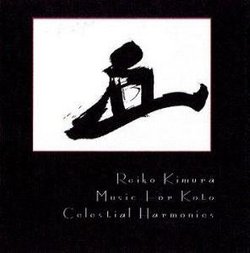A Classic CD of Contemporary Koto Music
Crazy Fox | Chicago, IL USA | 06/09/2006
(5 out of 5 stars)
"Well, the folks at Celestial Harmonies have done it again. Having already treated us to "The Art of the Koto" in three volumes, now they bring us this interesting, unique, and overall very nice CD of koto music. The performance is top-notch, the music is beautiful, and the crystal-clear sound quality brings these traits out to the full.
The focus of this CD is on contemporary koto music, making it somewhat similar to "The Art of the Koto (Volume 3)" in some ways, though it is not exclusively concerned with the 21-string koto as that CD is. Still, the 21-stringer shows up here along with the good old 13-string standard, which makes for a pleasant variety of sound. Track 1 is an old classic from the 1600's, but it is a favorite of the contemporary repertoire and so is included here (it also serves to give some context to the rest of the album). All the other tracks range in time from 1969 to as late as 1999. Matsumura Teizo's piece on track 2 manages to capture the feel of classical koto music in a way that is fresh rather then repetitive, while Miki Minoru's two compositions (Tracks 3 & 4) highlight his versatility and innovative flair--the incorporation of Javanese Gamelan music in "Higashi Kara" is especially striking. Finally, the subtle wistfulness of Sato Yoko's "Ame no Uta" (track 5) is incredibly moving; we can rest assured that the future of koto music is in good hands.
As with the other CDs by this company, the liner notes leave nothing to be desired. The context of the music featured on the disc and the development of different koto models in the twentieth century are aptly explained, and each track is discussed in detail suitable both to the casual listener and the music expert--including a brief description of the composer. Finally, a full bio on the careers of the two performers (mainly Kimura Reiko on koto but also Tajima Tadashi on shakuhachi flute for the second track) rounds it out. Heck, even the artwork on the cover gets a quick paragraph. All of this is a fine testament to the seriousness with which this product has been put together.
Unlike the "Art of the Koto (Volume 3)" which is a bit more esoteric, this CD stands alone fine and is a great sample of contemporary koto music. I can highly recommend it both to the long time koto-connoisseur and to the first-time listener."


 Track Listings (5) - Disc #1
Track Listings (5) - Disc #1